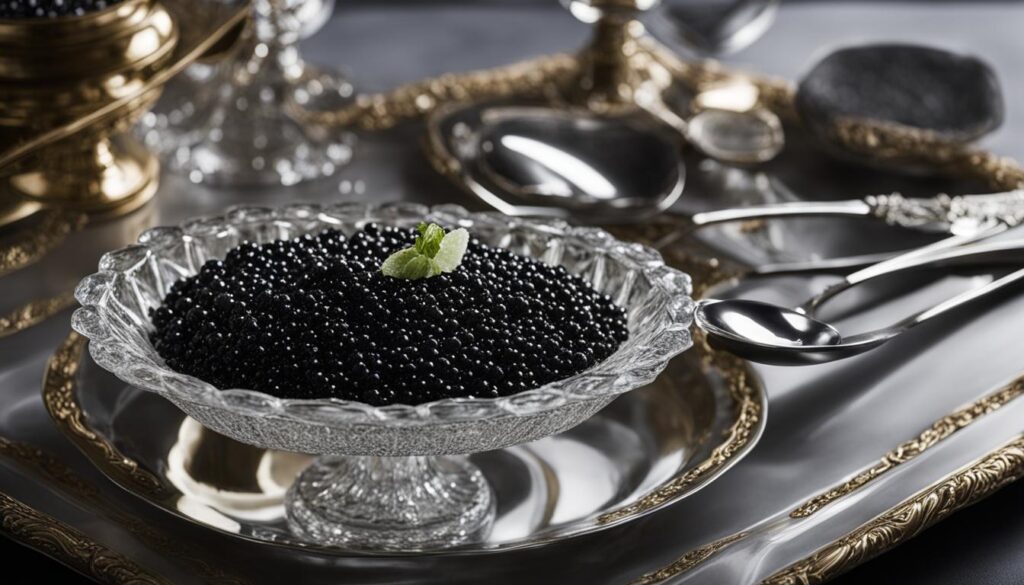The world’s best caviar represents the epitome of luxury and indulgence. From the exquisite flavors to the delicate texture, caviar is a delicacy that is highly sought after by connoisseurs around the globe.
Let’s explore the top-notch selections and unravel the secrets behind the world’s best caviar. But first, feast your eyes on this tantalizing image:
Key Takeaways:
- Caviar is considered the ultimate luxury in the culinary world.
- The flavor and texture of caviar are exquisite.
- The world’s best caviar is highly sought after by connoisseurs.
- Stay tuned to discover the secrets behind the world’s finest caviar.
The Rarity and Origin of World’s Best Caviar
The world’s best caviar owes its exceptional status to its rarity and origin. The most coveted caviar is sourced from the Caspian Sea and Black Sea regions, with countries like Iran, Russia, and Kazakhstan producing some of the finest varieties. These regions provide the perfect conditions for sturgeon, the fish from which caviar is derived, to thrive and produce top-quality roe.
Sturgeon, known for its prehistoric lineage, is a fascinating species that has been around for millions of years. These magnificent fish, which can live for several decades, are highly prized for their roe, which is carefully harvested and processed to create caviar.
The rarity of the world’s best caviar is attributed to the declining sturgeon population, primarily due to overfishing and habitat destruction. This scarcity has contributed to the coveted status and high price of this luxury delicacy.
“Caviar is a true luxury. Its rarity, coupled with its exquisite flavor and texture, makes it a highly coveted delicacy enjoyed by discerning palates around the globe.” – Chef Gordon Ramsay
While the Caspian Sea and Black Sea regions are known for producing the world’s best caviar, other countries such as the United States and France have also ventured into caviar production, offering unique and high-quality alternatives to the traditional varieties. However, the authenticity and distinctive flavors of caviar from the Caspian Sea and Black Sea regions remain unparalleled.
The Rarity of Sturgeon
Sturgeon, the fish from which caviar is derived, is a rare species that is now protected in many parts of the world. These majestic creatures are slow-growing and slow to reproduce, making them highly vulnerable to overfishing.
- Sturgeon can take anywhere from 7 to 25 years to reach maturity, depending on the species.
- Females typically produce caviar only once every 2-4 years, further contributing to its scarcity.
- Illegal caviar trade and inadequate regulations have further threatened sturgeon populations in recent years.
As a result, the sustainable production and conservation of sturgeon have become imperative to protect these magnificent fish for future generations to enjoy the world’s best caviar.
Next, we’ll explore the different types of caviar and the unique characteristics they offer.
The Different Types of World’s Best Caviar
The world’s best caviar comes in various types, each with its own distinct characteristics. Let’s explore the different types of caviar and their unique qualities:
Beluga Caviar
Beluga caviar is renowned for its large, lustrous pearls and is considered the epitome of luxury. Sourced from the Beluga sturgeon, this caviar delights the senses with its buttery texture and rich, creamy flavor.
Osetra Caviar
Osetra caviar, prized by caviar enthusiasts, boasts a nutty flavor and medium-sized grains. Harvested from the Osetra sturgeon, this caviar exhibits a robust taste that lingers on the palate, making it a favorite among connoisseurs.
Sevruga Caviar
Sevruga caviar, the smallest and most affordable variety, offers a slightly salty and briny taste. Extracted from the Sevruga sturgeon, its delicate pearls burst with flavor, making it an excellent choice for those seeking a more intense caviar experience.
“The different types of caviar cater to varying palates and preferences,” says renowned caviar expert, Chef Thomas Keller. “Whether you crave the rich and creamy texture of Beluga caviar or the distinctive nuttiness of Osetra, there is a caviar to suit every taste.”
When selecting caviar, personal preference and desired flavor profile play a crucial role. Some individuals may prefer the opulence of Beluga caviar, while others may find Osetra or Sevruga caviar more suited to their taste. Experimentation and exploration are key to discovering your preferred type of world’s best caviar.
| Type of Caviar | Characteristics |
|---|---|
| Beluga Caviar | Large pearls, buttery texture, creamy flavor |
| Osetra Caviar | Nutty flavor, medium-sized grains, robust taste |
| Sevruga Caviar | Small pearls, slightly salty and briny taste |
How to Enjoy the World’s Best Caviar
To truly savor the world’s best caviar, it is essential to follow a few guidelines. First, caviar should be served chilled but not frozen, as extreme temperatures can alter its taste and texture.
It is traditionally enjoyed on its own, accompanied by blinis or toast points, creme fraiche, and finely chopped onions or capers. These accompaniments complement the delicate flavors of the caviar, enhancing the overall experience.
The combination of the smooth, buttery texture of blinis, the creamy tang of creme fraiche, and the slight zestiness of onions or capers creates a symphony of flavors that perfectly balances the richness of the caviar.
Pro tip: Spread a thin layer of creme fraiche onto a blini or toast point, top it with a small spoonful of caviar, and garnish with a pinch of finely chopped onions or capers for the ultimate bite.
When it comes to enjoying caviar, the choice of beverage is equally important. The delicate, briny taste of caviar pairs exceptionally well with a glass of chilled champagne or vodka. The effervescence of champagne and the clean, crisp notes of vodka help cleanse the palate between each luxurious bite, ensuring that the flavors of the caviar shine through.
In summary, enjoying the world’s best caviar is a sensory experience that delights the taste buds and elevates any occasion. By following these guidelines, you can fully appreciate the exquisite flavors, textures, and aromas of this decadent delicacy.
The Price of World’s Best Caviar
As the epitome of luxury, the world’s best caviar comes with a hefty price tag. The rarity, quality, and demand for these delicacies contribute to their high cost.
Beluga caviar, being the most sought after and scarce, commands the highest prices, often reaching thousands of dollars per ounce. Osetra and Sevruga caviar can vary in price, with Osetra typically being more expensive due to its superior flavor profile.
The price of caviar is a reflection of its exclusivity and the craftsmanship required to produce it.
Conclusion
In conclusion, the world’s best caviar is the ultimate symbol of indulgence and luxury in the gastronomic realm. Its rarity and origin, sourced from the Caspian Sea and Black Sea regions, contribute to its unparalleled taste and quality.
With different types like Beluga, Osetra, and Sevruga caviar, each offering a unique flavor profile, there is a variety to suit every discerning palate. Whether it’s the lustrous pearls of Beluga or the nutty richness of Osetra, caviar takes the dining experience to new heights.
Although the price of the world’s best caviar may be substantial, it is a reflection of its exclusivity and the craftsmanship required to produce such a delicacy. Savoring caviar is an extraordinary experience reserved for those who appreciate the finer things in life, making it a truly luxurious choice for connoisseurs worldwide.
FAQ
What is caviar?
Caviar is a delicacy made from the roe or eggs of sturgeon, a type of fish.
Where does the world’s best caviar come from?
The world’s best caviar is sourced from the Caspian Sea and Black Sea regions, with countries like Iran, Russia, and Kazakhstan producing some of the finest varieties.
What are the different types of caviar?
The different types of caviar include Beluga, Osetra, and Sevruga, each with its own distinct characteristics and flavors.
How should caviar be served?
Caviar should be served chilled but not frozen. It is traditionally enjoyed on its own, accompanied by blinis or toast points, creme fraiche, and finely chopped onions or capers.
What should I pair caviar with?
Caviar is best paired with a glass of chilled champagne or vodka to enhance its delicate flavors.
Why is caviar so expensive?
The rarity, quality, and demand for caviar contribute to its high cost. The craftsmanship required to produce caviar also adds to its exclusivity and price.
















